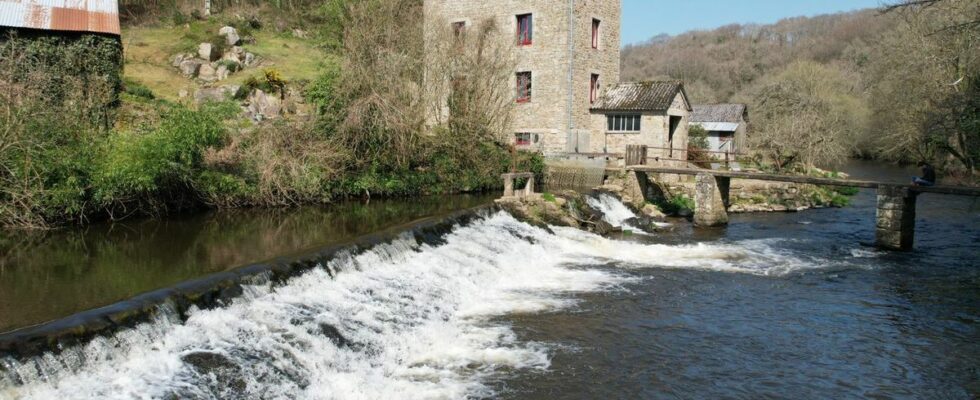It’s a long, very long story, which has regularly shaken the small town of Vieux-Marché for nearly forty years. In this small town located west of the Côtes-d’Armor, a mill is the subject of litigation between the State and the owners of the building. Installed on the Léguer, the Pont-Neuf mill has lived with its feet in the waters of the Breton river for more than two hundred years. A peaceful life that has long allowed him to produce flour with the only energy of the current. If the production had ceased about fifteen years ago, the monument continued to live thanks to the attachment of the great-grandson of a miller, who had inherited the famous mill and had recently converted into a lodge.
In conflict with the Côtes-d’Armor prefecture, Guillaume Scolan has just learned that all the valves and the water reservoir will have to be demolished by May 31. For him, the whole soul of the mill will be demolished. “We redid everything here, we kept the machinery, the tools… It’s probably one of the few mills that are so complete in Brittany. But when all the hydraulic works are removed, the whole mill is destroyed. By removing its function, we destroy the building”, regrets Guillaume Scolan. In 2021, the erasure of these thresholds, locks and dams had been at the heart of a battle between the Senate and the government.
Very touched by the decree of formal notice, the heir to the mill does not hesitate to criticize the “dogmatic position” of the prefecture of Côtes-d’Armor to which he reproaches his stubbornness in wanting to “destroy the mill”. Contacted, the administration agrees behind court decisions. Initiated by Guillaume Scolan, the legal battle largely turned in favor of the State, the town hall and several associations. Three times, the French justice considered that demolition work was necessary, dismissing the owner of his requests.
The reason for this decision? The necessary ecological continuity of the river, in which the fish are sometimes unable to swim due to the obstacles created by the Pont-Neuf mill. But also the risk of flooding that the Pont Neuf mill poses to its neighbor located a little upstream. “The completion of the work must allow the restoration of the natural state of the watercourse, to remedy the damage caused upstream by the Pont-Neuf mill and restore the ecological continuity to which it undermines”, estimates the prefecture.
“If we put dams, we modify the ecosystem”
Unlike the Vicomte mill located upstream, that of Pont-Neuf does not have a “water right” which had been granted to all the mills built before the law of August 4, 1789. The one located in Vieux-Marché dates, a priori, from 1791 and therefore does not have “the right” to deviate the course of the Léguer in this way. The prefecture recalls that in 2017, it had proposed to the owner “the regularization of the work, by removing the extension on the threshold and dismantling the valves”. Guillaume Scolan had refused and brought proceedings before the administrative court.
But beyond this thorny question of the right to water, it is above all the ecological impact of the mill that is the subject of debate. Does it affect the fish that live in the Léguer such as salmon, trout or eel? “Yes”, according to French justice. Especially in summer, when the river level is low and the obstacle becomes impassable.

This opinion is shared by Jean-Luc Pichon, member of the local fishing federation and administrator of the Eau et rivières de Bretagne association. The man grew up on the banks of the Léguer and knows the Pont-Neuf mill file perfectly. “A river is made to flow naturally. If we put dams, we modify the whole ecosystem”, assures the fisherman.
But why worry about it now, when the spillway has been there for more than two hundred years? “The mills have long been useful for the population. Their impact was less when the environment was in good condition. But today, with global warming and pesticides, the rivers are damaged, fragile. They no longer have the same resilience. The mills are not the only ones responsible, but they contribute to it, ”says the fisherman.
“I am not opposed to ecological continuity. I had also proposed the creation of a fish pass. But what scientific study do we have to prove that it is effective. I face a dogmatic vision of the free and wild river”, answers Guillaume Scolan. He cites the recent study by the geological engineer Pierre Potherat, who estimates that “the planned removal of the structures has led to the emptying of their upstream water reservoirs”. And therefore dried up the waterways.
An engineer by training, the man dreamed of operating a turbine to produce electricity using water alone. But for that, it was necessary to bring a maximum of current in the wheel of the mill, and thus to maintain a consequent dam in the bed of the river. This project will probably never see the light of day. The owner has until May 31 to carry out heavy work to dismantle the valves. As for the spillway, it will have to be demolished “by spreading stones in the river”, specifies the prefecture. Le Léguer will then find the flow it had before the French Revolution.

